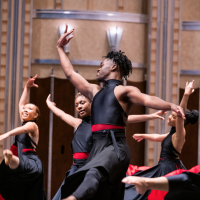“Imagination is more important than knowledge.” – Albert Einstein
Imagination: visualizing new possibilities for human thought and action and the use of materials.
Creativity: originality, flexibility and elaboration in making what was imagined.
The statement and definitions above were among several points of discussion at a meeting held last week at the Cleveland Foundation. We were the hosts for the Arts Education Partnership (AEP), a national coalition of arts, education, business, philanthropic and government organizations that promotes the role of the arts in the learning and development of every child, and the improvement of America’s schools.
AEP was founded and is supported by the National Endowment for the Arts and the U.S. Department of Education in cooperation with the Council of Chief State School Officers and the National Assembly of State Arts Agencies. The Partnership is composed of more than 140 organizations that are national in scope and impact. It also includes state and local partnerships focused on influencing educational policies and practices to promote quality arts education.
The day-long meeting included local arts education specialists and champions from the Cleveland Metropolitan School District, Young Audiences, area foundations, the Community Partnership for Arts and Culture, Playhouse Square, and Cleveland State University. There also were representatives from Columbus, Dallas, and the state of Oklahoma.
So what did we talk about? The discussion focused on AEP’s efforts to foster an affinity group for arts education, and to help all Americans – regardless of occupation, social standing, income level, geographic location, race, etc. – who believe in the value of the arts in children’s education form themselves into a collective force for change. Like those who self-identify as “environmentalists” or “soccer moms” (people who can see they are among many across the spectrum that share a core value), such an “affinity” group could come to wield significant influence in the coming election. AEP aims to create and position this cluster for arts education.
In their focus group work, AEP constantly heard people say that the current system teaches children to be “average,” at best. One passionate arts champion put it more colorfully: “We teach to the floor. At the end of the day, children are still under the table. We need them to be able to sit at the table.”
AEP’s polling and research confirms that more and more people believe our schools do not prepare children with the skills they need for the future. As Daniel Pink says in his recent book “A Whole New Mind” (which I am recommending to all of my colleagues), we are no longer in the knowledge economy. The economy of today and tomorrow is one of concept and imagination – of making meaning out of what we know and what we make. It will require students to acquire habits of mind and the cognitive capacity for imagination that are nowhere more effectively taught than through the arts.
AEP came to Cleveland because Ohio has established a Committee for the Arts in Education and is developing a state-wide plan for arts education. The arts are now a criteria for inclusion in the state’s STEM (Science, Technology, Math, Engineering) Schools Initiative. And Cleveland is recognized as a progressive city in this area because of the passage of Issue 18 on a platform of arts education, our inclusion in a major Ford Foundation urban district arts education initiative, because our cultural organizations have formed a coalition for arts education, and because of the long history of the ICARE (Initiative for Cultural Arts in Education) program that the Cleveland and Gund foundations, among others, have supported in Cleveland schools for more than a decade.
Oklahoma also has a state-wide arts education initiative, and the city of Dallas has made great strides in integrating the arts into its public school district, which is among the largest in the country.
The meeting held here at the Cleveland Foundation was an important step in crafting messages and interpreting research that will be used in AEP’s national efforts over the next year. So you can expect to hear more about the value of arts-integrated learning as our presidential campaign unfolds, and perhaps you will be called on to declare yourself a member of the ImagiNation.

Pingback: Kathleen Cerveny on the Arts Education Partnership | Brewed Fresh Daily